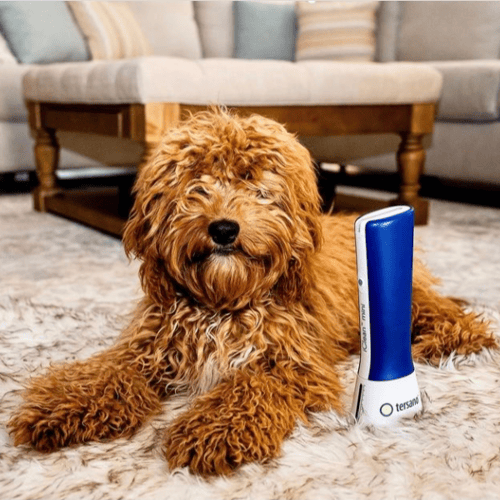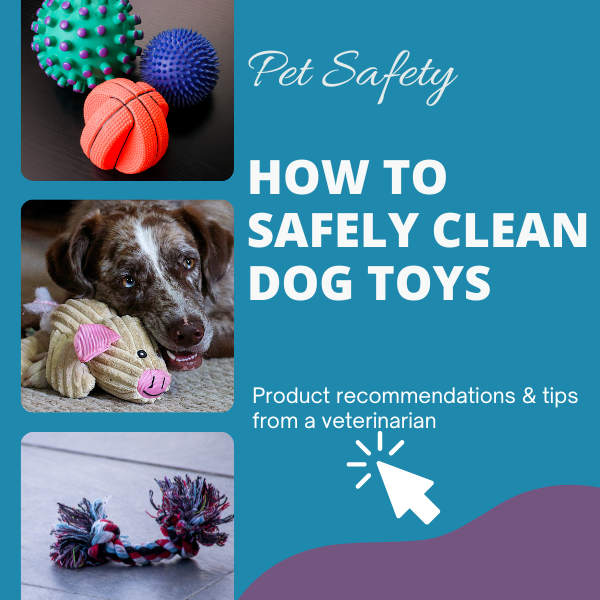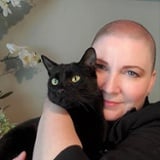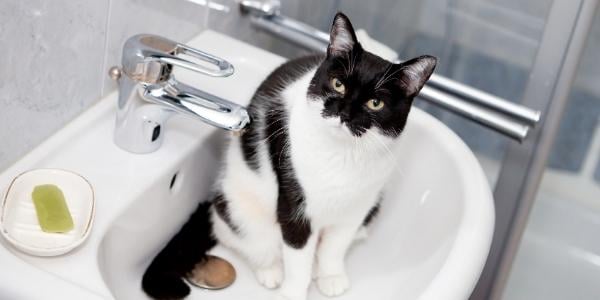 I was in my early thirties when I had my moment of cleaning clarity.
I was in my early thirties when I had my moment of cleaning clarity.
Soaking the countertop with some bleach-filled liquid and reading the back of the bottle to see what I needed to do to make sure I was safe, it occurred to me, “What about my cats who walk all over these surfaces and then lick their toe beans?”
That’s when I started paying attention to the cleaning products I was using around my pets.
Our dogs and cats have a different relationship with household products than we do. I imagine most of us aren’t walking across the coffee table or licking a treat up off the tile.
They’re rolling around on the floor more than we are. And I’d venture a guess that very few of us are grooming ourselves with our tongues. But our pets are. That means whatever their bodies come into contact with can be ingested.
They also tend to breathe more deeply and rapidly than those of us on two legs. They’re taking in airborne particles that may seem harmless but can actually be incredibly toxic to dogs and cats.
We’re going to give you the information you need for your own “moment of cleaning clarity,” breaking down the hazards found in many off-the-shelf and DIY cleaning products and giving you some safe alternatives.
You may even find that swapping out some of your old cleaners for safer versions will help your health as well.
Skip to section:
Pet-Safe Household Cleaning Products
There are many harmful ingredients in popular, everyday cleaning products. See the list of these toxic ingredients below, but thankfully, more and more pet-friendly cleaning products are coming out every year.
Before I discuss our top choices from the “grocery store shelf,” we have a non-traditional one we’re thoroughly impressed with. So much so that we partnered with the company because this is the safest cleaning product you will find – for pets and people.
For decades, it’s been used in food manufacturing and health institutions, including hospitals and zoos. But now, they have a small (mini) household cleaning device.
Named Time Magazine’s Best Invention of the Year in 2006, Tersano’s iClean® mini is an environmental option that is 50% stronger than bleach. Use code petsafe10 at checkout for 10% off.
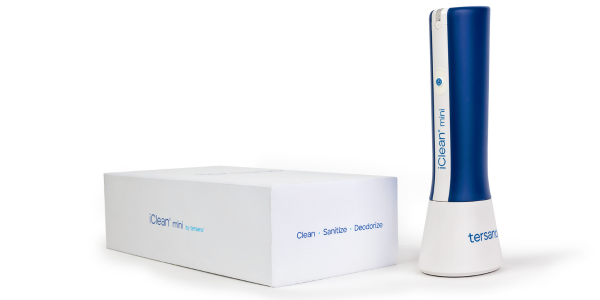
It works by using electricity to change oxygen molecules (O2) into a special type of oxygen called ozone (O3). This ozone is then mixed with regular tap water to create a strong disinfectant.
When the ozone comes in contact with germs and dirt, the third oxygen molecule bonds to them and makes them harmless. What’s left behind is just regular oxygen (O2) and water. So, it’s a safe and effective way to clean and disinfect your home without harsh chemicals.
It kills many things, including COVID-19, Salmonella, E.coli, Listeria, Parvo, etc. See this list for more pathogens and how long the water/ozone needs to stay on the surface (generally 30 seconds to 5–15 minutes).
See all the ways the iClean mini can be used, even for cleaning food.
Top Pet-safer Cleaners
Warning: Just because these products are safer for pets doesn't mean they are 100% safe. Pets should still be discouraged from licking surfaces cleaned with these cleaners as much as possible. However, if you use the iClean mini featured above, your pet can safely lick anything cleaned with it.

Biokleen designs their products with pets in mind, understanding their sensitivity to toxins, synthetic dyes, and artificial fragrances. They steer clear of phosphates, chlorine, ammonia, petroleum solvents, alcohol, butyl, glycol ether, brighteners, artificial color, and artificial fragrance.
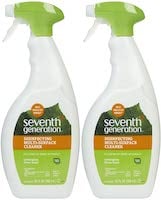
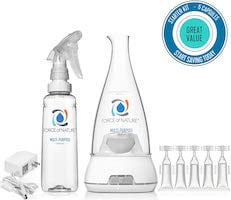
Force of Nature is an EPA-registered disinfectant and sanitizer that kills 99.9% of germs using only 3 ingredients: water, salt, and vinegar. Adding an electrical current forms two new ingredients that naturally clean and disinfect: hypochlorous acid and sodium hydroxide. I've been using this product for a few years and wouldn't go without it. Bonus - it's great for getting rid of odors on soft furnishings instead of using a fabric spray.
Pet Safety Note About Pine-Sol
We have been asked if Pine-Sol® is safe for pets. Our veterinary team has reached out to the manufacturer, the Clorox Company, and we'll update you when we hear back. But this is what we've uncovered from our research into Pine-Sol's ingredients.
Their alternative to ammonia is C10-12 alcohol ethoxylates, which cleans but evaporates without leaving a residue. Other ingredients that make up more than 1% of the product are listed: glycolic acid, fragrance, caramel, dimethicone/silica/PEG distearate, sodium, C14-17 secondary alkyl sulfonate, and xanthan gum.
Our vet team looked at the remainder of the ingredients and didn't see any red flags when it comes to being toxic to pets; most ingredients are used in human cosmetics.
Now, with all this being said, while none of the ingredients are directly harmful to pets, it's certainly not something you want them ingesting, and the smell could turn off some animals or trigger asthmatic reactions, which is possible with anything that has a strong scent.
Cleaning Products That Are Good for the Environment
If you want more information, the Environmental Working Group (EWG) lists cleaning products and grades them for their impact on the environment and their toxicity to humans. If you search for Pine-sol, you'll see their take on it.
Please note: that the "top" products listed on their site are better for the environment but not always appropriate to use around animals, so stick to products like the ones we list above, which are at the top of the EWG list.
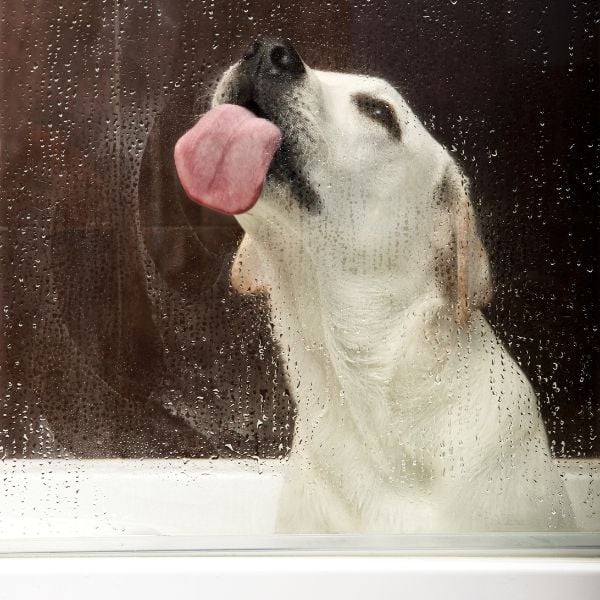
Pet-Safe Window & Glass Cleaner
For those dogs who love to lick windows, especially the windows in the car or the shower glass when having a bath, the best option is to use a pet-safe window cleaner that doesn't use dangerous chemicals.
One of our colleagues uses a cloth on her windows that works well with just water and no cleaner! She swears it doesn't leave streaks. And the E-cloth brand has clothes for just about any cleaning need.
One of the safest glass cleaners on the EWG list is Sensitive Home Glass Cleaner. If you don't have any grime on your windows, you can use the E-cloth mentioned above and just use water. And if you have grime and want to use (just) water, consider the iClean® mini.
Make Your Own Pet-Safe Household Cleaners
If you prefer homemade DIY options, look at using ingredients like:
- Distilled white vinegar: effective for killing bacteria and microbes. Anti-fungal properties also make it a good option for mold treatment.
- Baking soda: has long been used to absorb odors. It’s also mildly abrasive, so it’s great for scrubbing tubs, sinks, etc. Working alongside vinegar, baking soda can take on stubborn clogged drains and tackle grease.
- Hydrogen peroxide: true, it’s a bleaching agent. But it’s not damaging like chlorine. The breakdown process of hydrogen peroxide turns it into water and oxygen. It can be used in antiseptic and anti-fungal applications like killing mold and odors.
- Lemon juice: if you’re looking for something a little less potent than vinegar, it’s a great antibacterial and anti-fungal. You can take a lemon wedge after you've used the juice and rub it on wood cutting boards and surfaces.
These ingredients can be combined in several ways to clean different areas of your home effectively. Need some inspiration?
5 DIY Household Cleaners that Are Pet-safe
Pet-Safe DIY All-Purpose Cleaner
- Equal parts water and distilled white vinegar.
Works on tile, linoleum, vinyl, cabinets, appliances, sinks, and more.
Pet-Safe DIY Bathroom Cleaner
- 1 cup distilled white vinegar (5% acetic acid)
- 1 cup hydrogen peroxide (3% solution)
Place vinegar and hydrogen peroxide in separate, labeled, dark-colored spray bottles. Generously spray the area with vinegar. Let it sit for five minutes, then wipe the entire area that was sprayed. Then, respray the entire area with the hydrogen peroxide. Let it sit for ten minutes, then wipe it clean.
DO NOT mix hydrogen peroxide and vinegar, especially non-retail (industrial) grades. This can create peracetic acid, exposure to which can potentially harm the eyes, skin, nose, throat, and lungs.
Pet-Safe DIY Shower Cleaner
- 2 oz. dish soap
- 4 oz. bottled lemon juice
- 8 oz. distilled white vinegar (5% acetic acid)
- 10 oz. water
Mix ingredients. Spray the shower and let sit. Rinse. For extra shine, wipe with a dry towel.
Pet-Safe DIY Carpet Stain Remover 1
- ½ cup hydrogen peroxide (Because hydrogen peroxide can potentially bleach or lighten dark carpets or rugs, it's best to test a small area first.)
- ½ cup dish soap
Combine hydrogen peroxide and dish soap in a dark-colored spray bottle. Fully mix prior to use. Blot up as much of the stain as possible prior to cleaning.
Spray the area and let sit for a couple of minutes. Gently scrub the area with a bristle brush, then spray with hot water. Blot with a clean rag. Repeat blotting until the stain and residue of the dish soap are gone.
Pet-Safe DIY Carpet Stain Remover 2
- Baking soda
- Distilled white vinegar
Blot up as much of the stain as possible prior to cleaning. Sprinkle the area with baking soda and allow to sit overnight. Then spray the area with vinegar — don't panic if you notice the carpet bubbling; that's normal.
Let the area dry for several hours, and then vacuum.
Pet-Safe DIY Carpet Stain Remover 3
- 1 cup distilled white vinegar (5% acetic acid)
- 1 cup water
- 2 large scoops of baking soda
Mix all three ingredients together in a spray bottle and shake well to combine. Blot up as much of the stain as possible prior to cleaning. Spray the affected area, let dry completely, then vacuum.
Pet-Safe DIY Cleaning Scrub
- Equal parts water, baking soda, and salt
Mix into a thick paste. Scrub and rinse well.
Pet-Safe DIY Drain Cleaner
- ½ cup baking soda
- 1 cup white vinegar
Pour the baking soda into the drain. Add white vinegar and let sit for 10 minutes, then pour boiling hot water down the drain. Repeat as necessary.
Safety Note: When making your own household cleaners, don't allow your pet to ingest the ingredients directly, as this may cause digestive upset or vomiting.
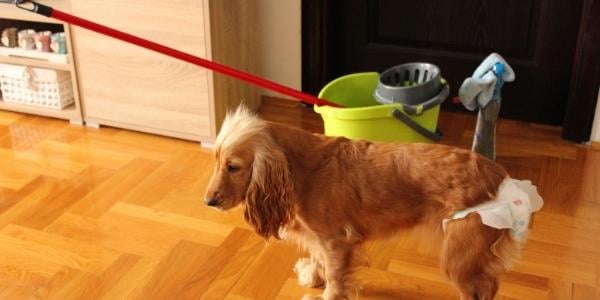
Cleaning Product Ingredients That Could Be Harmful to Your Pets
Ammonia
Ammonia (or ammonium hydroxide) is a nasty one. It can burn mucus membranes and cause breathing problems if inhaled. When licked, ammonia can burn the inside of the mouth, throat, and stomach. Not only is it used on its own, but it’s also an ingredient in many products such as oven, window, carpet, and drain cleaners, plus countertop sprays and degreasers.
But things get really scary if you mix ammonia with bleach. This dangerous combo creates a poisonous gas that can be deadly.
Side note: ammonia also creates that strong smell you get from cat urine. That’s why many cats avoid using a litter box that hasn’t been cleaned recently. They’re avoiding ammonia.
Windex® Glass Cleaner with Ammonia-D, many Lysol® disinfecting products, Downy® Infusions, and Mop & Glo® are just a few of many household cleaning products that contained ammonia at the time this article was written. And, of course, ammonia is often used on its own or in DIY cleaners.
Benzalkonium Chloride
Here, we’re dealing with an antimicrobial agent that can be found in antibacterial cleansers, mold removers, household disinfectants, and patio cleaners.
It can cause tissue damage, gastrointestinal irritation, and more if your pet licks or touches a surface where you’ve used products containing Benzalkonium Chloride. Lysol®, Scrubbing Bubbles®, Softsoap®, Clorox® Disinfecting Wipes, and Purell® are among those listed in the Consumer Product Information Database.
Chlorine (Bleach)
Another big offender is chlorine. You’ll find it everywhere — kitchen and bathroom sprays, laundry and dish detergent, and toilet bowl cleaner. It’s also commonly used around the house with a water dilution for disinfecting.
Think about any time you’ve used a chlorine bleach product. You’ve got the doors and windows open for ventilation. And half the time, you probably have your shirt collar pulled up over your nose. It can seriously irritate the respiratory tract.
With cats and dogs breathing deeper and faster than humans and having much more sensitive noses, you can imagine how rough it must be on them. And remember, they’re walking across these surfaces and licking their paws. They may be drinking from the toilet bowl or from a trickle of water in the sink that you’ve just cleaned with a chlorine product.
And there’s another deadly combo to watch for. Chlorine bleach mixed with vinegar creates chlorine gas, so toxic a variant was used to knock out Allied troops in the trenches during WWI.
Formaldehyde
Formaldehyde — yes, the one used to embalm bodies — can be found in lots of household cleaners, hand soaps, and even pet shampoo. It’s actually a naturally occurring gas in our bodies. The problem comes from inhaling high concentrations in the air.
Where do those airborne particles come from? They’re released in small quantities from products that use formaldehyde or formaldehyde-releasing preservatives. If we’re breathing them in, so are our pets. That’s a lot to digest, figuratively and literally.
A quick search of the Consumer Product Information Database provides a lengthy list of products with formaldehyde, including, sadly, some pet grooming products and many household cleaners.
Products from Palmolive®, Gerber®, and Softsoap® are on the list. And that doesn’t include other formaldehyde-releasing chemicals like DMDM hydantoin, Diazolidinyl urea, imidazolidinyl urea, and Quaternium-15.
We can’t completely avoid formaldehyde gas. But it’s in our best interests to limit it where we can — for our pets and ourselves.
Glycol Ethers
Glycol Ethers are a chemical ingredient found in many household cleaners — even some labeled as “natural.” They’ve been found to cause digestive, liver, and nerve damage, not to mention being linked to lung and kidney damage and anemia, not just in animals but in people, too. You’ll often find them labeled as “nonionic surfactants” or “glycols” on ingredient lists.
Fragrance (Phthalates and essential oils)
This is an excellent time to point out that even natural, organic ingredients can be toxic to our pets. Some of my favorite essential oils are now off-limits in my home because they’re dangerous for my cats, even though they’re perfectly natural and healthy for me.
Whether you’re using essential oils in your own DIY cleaning concoctions or they’re an ingredient in a product you’re buying, it’s a good idea to do a little scent research so you can make safe choices. We also have some pet-safe essential oil recipes.
Disclaimer. Even when natural scents are used, it’s still important to identify them and make sure they won’t irritate your pet’s sensitive nose. Go unscented when possible. And remember, cats don’t love citrus.
Avoid using citrus products, especially around litter boxes and other areas you want your cat to frequent.
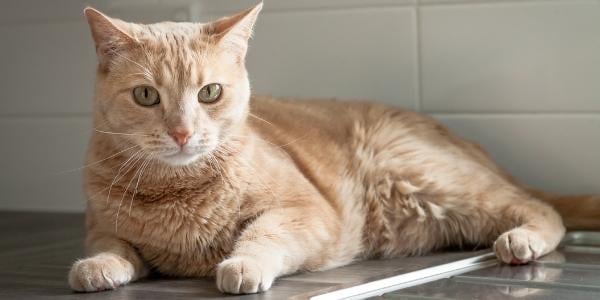
When it comes to Phthalates, you may not see them listed explicitly in cleaning product ingredients. But if you see “fragrances” or “perfumes,” there’s a decent chance Phthalates are one of the solvents used to dissolve those fragrances.
This sneaky chemical can cause allergic symptoms and asthma. And there’s generally a lot of concern around how Phthalates disrupt things in our bodies. Again, if it’s dangerous to us, it’s often even more dangerous to our pets.
You may not be able to avoid all of these ingredients. But you can still help your dogs and cats by following the manufacturer’s instructions precisely and using proper ventilation.
Remove your pets from the area until all surfaces are completely dry. Make sure food and water bowls, toys, and bedding are out of the area as well. And look for references to “pet safe” as you peruse the cleaning products aisle at the store.
Questions? If you're concerned and want to chat with a veterinarian about a product your pet licked or ate, Click here
Symptoms of Toxicity in Pets
If there’s any chance your pet ingested, inhaled, or came into contact with a harmful toxin, call a veterinarian right away. Better safe than sorry!
Be on the lookout for these symptoms and signs – they will vary based on the type and quantity of the product ingested:
- Vomiting
- Diarrhea
- Poor to no appetite
- Drooling
- Irritation of the skin and eyes
- Weakness
- Distended or swollen belly
- Seizures
Corrosive-specific Symptoms:
- Red, raw skin that may have blisters
- Inflammation of the mouth and eyes – burns and lesions in the mouth are possible
- Vomiting or retching
- Pain
- Severe drooling and pawing at the face
- Difficulty breathing
- Lethargy
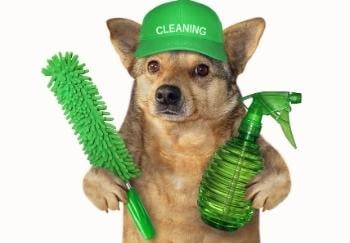
There are 24-hour resources available. The ASPCA Animal Poison Control Center and Pet Poison Hotline are always on call. There is a fee for their service, but it could save your pet's life.
The Consumer Product Information Database is a helpful resource providing lists of products containing specific ingredients.
Their database is currently supported by the National Institute of Environmental Health Sciences (NIEHS) of the National Institutes of Health (NIH), the U.S. Public Health Service, and the Department of Health & Human Services.


